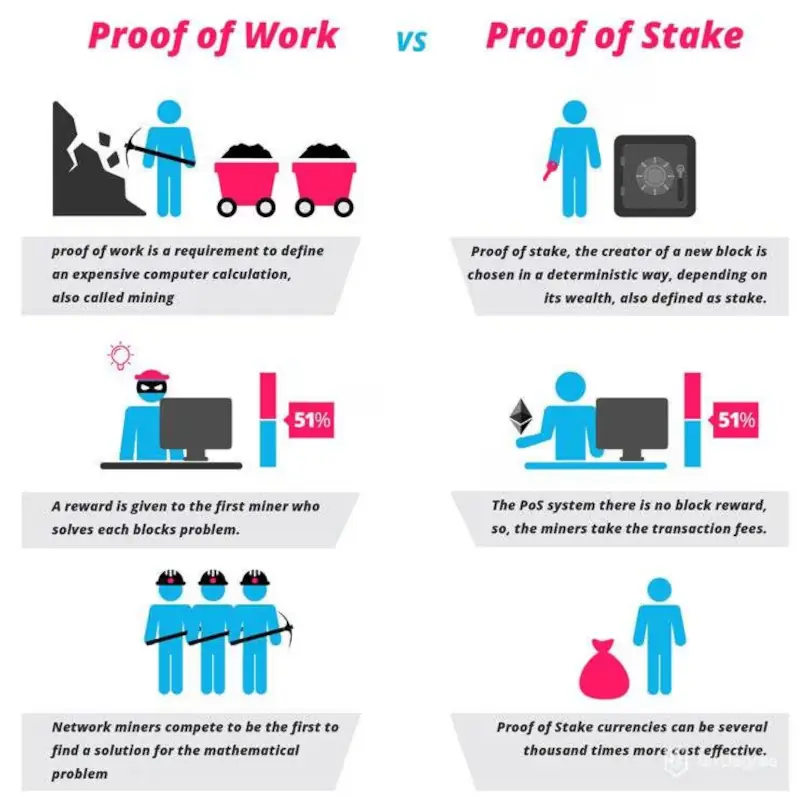Introduction to Proof of Stake (PoS) in Cryptocurrency

One of the major issues in the crypto industry has been consensus, the method through which transactions are processed and network security is maintained. Bitcoin, the first-ever cryptocurrency, has been famously criticized for its very high energy consumption as a result of its Proof of Work consensus method, causing more energy consumption than many European countries.
As an alternative, Proof of Stake was developed.
Definition and Basic Concept of Proof of Stake
Proof of Stake (PoS) is a consensus mechanism in cryptocurrencies where block validators are chosen based on the amount of cryptocurrency they hold and “stake” in the network.
Instead of solving complex mathematical problems like in Proof of Work, PoS relies on validators having a financial stake, incentivizing them to act honestly and validate transactions accurately. Validators are selected to create new blocks based on their staking percentage, leading to a more energy-efficient and scalable system.
Advantages and Disadvantages of Proof of Stake
Proof of Stake (PoS) has several advantages. It is more energy-efficient compared to Proof of Work, reducing environmental impact. PoS also allows for higher scalability and faster transaction processing.
However, PoS is criticized for potentially centralizing power in the hands of those with the most wealth, leading to concerns about security and decentralization.
How Proof of Stake Works
Proof of Stake (PoS) works by allowing participants to “stake” their cryptocurrency holdings to validate transactions and create new blocks.
The probability of being chosen is proportional to the amount staked, incentivizing participants to have a larger stake. Validators take turns verifying transactions and adding them to the blockchain, earning rewards in return. This consensus mechanism aims to ensure security and decentralization in PoS-based cryptocurrencies.

The Proof of Stake (PoS) system incentivizes stakers by rewarding them with additional cryptocurrency in return for their participation in the network. Stakers earn rewards based on the amount they have staked, encouraging them to hold and validate transactions.
This provides an incentive for users to contribute to the security and stability of the blockchain, fostering a more active and engaged community.
Addressing potential security issues in Proof of Stake is crucial for maintaining the integrity and trustworthiness of the system. Measures like slashing penalties, where validators lose a portion of their stake if they behave maliciously, are implemented to deter fraudulent activities. Randomization algorithms and protocols for validator selection also help reduce the risk of collusion and concentration of power, ensuring a more secure and decentralized network.
Popular Proof of Stake Cryptocurrencies
Popular Proof of Stake cryptocurrencies include Ethereum, which changed to proof of stake in September 2022 a transition to Proof of Stake with its ETH 2.0 update, reducing its carbon emissions by 99%.
Other notable examples are Cardano and Tezos, both known for their efficient and secure PoS consensus algorithms. These cryptocurrencies have gained traction for their potential scalability and energy efficiency compared to traditional Proof of Work systems.
Comparison between Proof of Stake and Proof of Work
Proof of Stake (PoS) and Proof of Work (PoW) are two different consensus mechanisms in cryptocurrency. While PoW relies on miners solving complex mathematical puzzles to validate transactions, PoS validators are chosen based on the amount they stake in the network.
Unlike PoW, PoS consumes significantly less energy and offers better scalability. However, questions regarding security and decentralization remain when compared to PoW.
Future Trends and Considerations in Proof of Stake
As the cryptocurrency industry continues to evolve, there are several future trends and considerations to keep in mind when it comes to Proof of Stake (PoS).
The transition to Proof of Stake (PoS) systems, particularly by major cryptocurrencies like Ethereum, could have a significant impact on the cryptocurrency industry. PoS offers advantages such as energy efficiency and improved scalability, which may attract more users and investors to PoS-based cryptocurrencies. This shift could also lead to greater decentralization and security within the industry.









